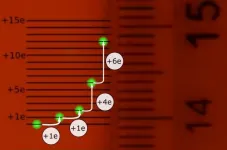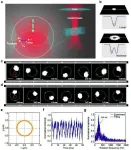(Press-News.org) The ability to insert desirable genes into animal or human cells is the basis of modern life science research and of widespread biomedical applications. The methods used to date for this purpose are mostly non-specific, making it difficult for scientists to control which cell will or will not take up a gene. For this gene transfer, the target genes are often packaged into "viral vectors." These are viruses in which part of the genetic material has been replaced by the target genes. When researchers add these viral vectors to cells, the vectors introduce the genes into the cells. This is the principle behind some of the current SARS-CoV-2 vaccines such as those from AstraZeneca or Johnson&Johnson. However, it is difficult - even impossible - to control into which cells the target genes enter, since the viral vectors tend to dock non-specifically onto all cells of a certain cell type. A team of researchers from the Cluster of Excellence CIBSS - Centre for Integrative Biological Signalling Studies at the University of Freiburg, led by Dr. Maximilian Hörner, Prof. Dr. Wolfgang Schamel and Prof. Dr. Wilfried Weber, has developed a new technology that enables them to introduce target genes in a controlled manner and thereby control processes in individual selected cells. The researchers have published their work in the current issue of Science Advances.
Alteration to a viral vector
In their new method, the Freiburg researchers introduce the genetic information with an optical remote control. As a result, only cells that are illuminated with red light take up the desired genes. To do this, the scientists modified a type of viral vector known as an AAV vector, which is already in clinical use. "We took away the viral vector's ability to dock with cells," Hörner explains, "which is an essential step before the genetic material can be introduced."
To enable this control by light, the researchers have taken a red light photoreceptor system from the plant Arabidopsis thaliana (thale cress). This system consists of two proteins, PhyB and PIF, which bind to each other as soon as PhyB is illuminated with red light. The Freiburg team placed the protein PIF on the surface of the viral vector and modified the other protein PhyB so that it could bind to human cells. Once this modified vector, called OptoAAV, is in a cell culture along with the cell-binding protein, the protein binds to all cells. "If a selected cell is now illuminated with red light, the modified vector can bind to this cell and introduce the target genes into the illuminated cell," Hörner explains.
A key aspect of biological signal research
This new approach allows the researchers to introduce target genes into the desired cells within a tissue culture. The scientists also succeeded in illuminating the tissue culture successively at different locations, thus enabling the targeted introduction of different genes into different cells within a culture. With this technique, it is now possible to control desired processes in individual cells. This is essential for understanding how a single cell communicates with cells in its environment, for example, to control the development or regeneration of an organ. "As these viral vectors become more widely used in the therapeutic field," Weber says, "we think this new technology has the potential to make such biomedical applications more precise."
Cluster of Excellence CIBSS - Centre for Integrative Biological Signalling Studies
Researchers in the Cluster of Excellence CIBSS - Centre for Integrative Biological Signalling Studies at the University of Freiburg are investigating the fundamental communication processes that determine multicellular life in humans, animals and plants. In this way, they aim to gain a higher-level, integrative understanding of biological signaling processes in order to develop tailored molecular tools using methods from synthetic and chemical biology to precisely control signaling processes. In this way, the researchers seek to develop strategies for the treatment of cancer using immunotherapies or for resource-conserving crops production, among other things. Maximilian Hörner and Wolfgang Schamel are group leader in the Cluster of Excellence, Wilfried Weber is a member of the speaker team.
INFORMATION:
Publication:
Hörner, M., Jerez-Longres, C., Hudek, A., Hook, S., Yousefi, O. S., Schamel, W. W. A., Hörner, C., Zurbriggen, M. D., Ye, H., Wagner, H. J., Weber, W. (2021): Spatiotemporally confined red light-controlled gene delivery at single-cell resolution using adeno-associated viral vectors. In: Science Advances. Vol. 7, No. 25. DOI: 10.1126/sciadv.abf0797
Tsukuba, Japan - Sometimes a dead log isn't just a dead log. This one in Japan turned out to be the habitat of a species previously unknown to science.
In a new study published in the journal Nematology, a University of Tsukuba-led research team has described a new species of nematode found inside bark beetles that emerged from a dead log of a fir tree.
Nematodes, also known as roundworms, are a diverse phylum (category) of unsegmented worm-like animals that live in a wide variety of habitats and have diverse life habits. Many nematodes, including this previously unknown species, are either parasitic or live inside a host organism for the duration of a particular life stage.
The log from the trunk of a fallen Veitch's fir tree (Abies veitchii) was ...
Southeast Asian monsoon region falls in the warm and humid tropics modulated by Asian monsoon. It is home to nearly 15% of the world's tropical forests and one of the biodiversity hotspots in the world.
With the unprecedented urbanization and population growing rate, water scarcity issues have already posed a serious challenge for sustainable development in Southeast Asian monsoon region. However, the impact of anthropogenic forcing, such as greenhouse gases and anthropogenic aerosols, on extreme drought events in the region is still unclear.
Scientists from the Institute of Atmospheric Physics (IAP) of the Chinese Academy of Sciences investigated the observed drought changes over Southeast ...
Researchers at the University of Gothenburg have observed the absorption of a single electron by a levitated droplet with such a magnification that it is visible with the naked eye and can even be measured with a normal millimeter scaled ruler.
Matter in the universe is composed of elementary particles like electrons, protons, and neutrons. They are everywhere, but they are so small that the human eye cannot discern them. In the last century, physicists have proven the existence of these particles through different experiments, but in most cases the observation of the particles have been indirect.
- Electrons are one of these fundamental particles. In 1909, Robert Millikan proved that the charge of the electron is quantized. In other words, there exists a minimum, indivisible ...
Researchers from Skoltech and Saratov State University have designed a simple and easily reproducible labeling system for individual cells that enables researchers to track single cell behavior and migration for tasks requiring extreme precision. The paper was published in the journal ACS Applied Materials and Interfaces.
Modern biomedical science and developmental biology often require scientists to track and trace individual cells, whether it is to establish the best purified cells from various types of cell lines, in particular to select mesenchymal stem/stromal cells best suited for tissue ...
The production of chemicals is a cumbersome business. Often, only a small part of what is actually wanted is produced in the factory. The large remainder is unusable - or even worse. Examples? The defoliant "Agent Orange" used by the US army in the Vietnam War was produced in great hurry. It contained dioxin as an impurity. As a result, not only did trees in the combat zone lose their foliage, but US soldiers and Vietnamese civilians also fell ill with cancer years later.
There are also examples from agriculture: In the production of the insecticide lindane, ...
As a new member of photovoltaic family, antimony trisulfide (Sb2S3) has the satisfactory bandgap of 1.7eV, benefiting the fabrication of the top absorber layer of tandem solar cells. Due to special quasi-one-dimensional structure, it shows advantages of less dangling bonds. Based on these advantages, the vacancy defects upon the surface causing the recombination of the carriers could be reduced sharply, which helps to solve the photovoltaic problems in solar cells.
In the previous studies, the relationships between conformation, chemical composition and ...
Scientists have developed a new method that improves dispensing of viscoelastic fluids - a vital process for circuit board production, 3D printing and other industrial applications
Viscoelastic fluids are difficult to dispense as liquid bridges that form between the substrate and nozzle must be broken
New research has found that twisting these liquid bridges breaks them in a quicker and cleaner way than the conventional method of stretching them
Researchers used high speed imaging to observe that when twisted, a crack forms at the edge of the liquid bridge and propagates towards the center
The underlying mechanism that breaks the liquid bridge was found to be "edge fracture" and is the first time that ...
During flock encounters, a single vocal interaction seems to be sufficient for making the decision of whether to recruit an individual or flock. Parrots are known for their splendid ability to imitate, including the contact calls of other individuals during vocal interactions. Such rapid vocal matching is hypothesised to precede and mediate the formation of new flocks. But how are such interactions perceived by others?
Heidi M. Thomsen, first author and PhD student at the Department of Biology, University of Copenhagen explains:
-"By using a novel experimental design, we were able ...
Seiichi Shirai (1905-1983) was an influential architect whose work has affected the designs of significant architects of the 20th century. Associate Professor Kosuke Hato of the Department of Architecture, Faculty of Engineering, Shinshu University has studied the work of Shirai and examined why the architect worked extensively on calligraphy. Hato's strategy is to clarify the relationship between the architect and his activity of calligraphy through Shirai's Theory of Tradition.
The 1950s in Japan is known as a time when architects actively discussed traditions, and Shirai is a representative example. Hato, in his past article, clarified not only the ...
Is it possible to drive nanoparticles to orbit below the light diffraction limit using a Gaussian beam? A recent joint research project reported in Nature Communications says yes.
It is well known that light possesses not only energy but also momentum. When light irradiates an object, momentum is transferred to the object, thus generating light pressure on the object. At the microscopic scale, microparticles and nanoparticles (such as biocells and macromolecules) can be manipulated by the light force. Atoms can be cooled by light pressure to achieve atomic clocks, Bose-Einstein condensation, and so on.
In addition to the linear momentum of light being transferable, the angular momentum of light can also be transferred to an object, thus causing object rotation. Since ...






